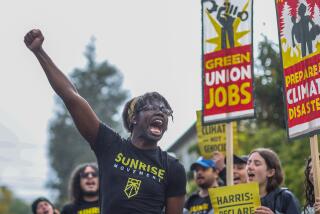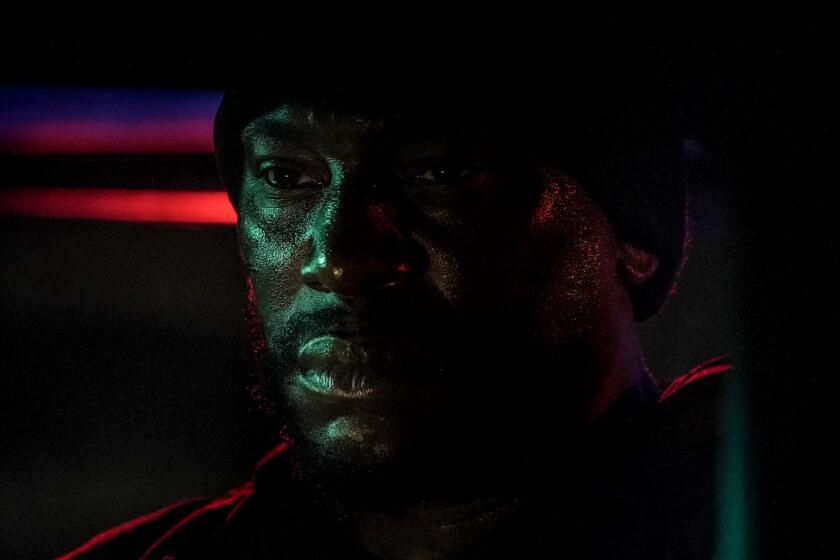Al Gore warms up to a very hot topic
Critics have labeled Al Gore and his decades-long crusade to curb global warming as “alarmist.” But if you’ve been warning people that the sky is falling for more than 20 years and it really is falling (or at least heating up), don’t you have an obligation to sound an alarm?
The highly persuasive documentary “An Inconvenient Truth” captures Gore delivering a multimedia presentation he has given an estimated 1,000 times since 1989. The talk is augmented with an impressive array of graphs, animation, anecdotes and statistics that convey a flurry of facts, projections and conjecture, all pointing to the ill effects the present rate of emissions has on the environment. A film with a clear point of view (and little room for others), it is the inspiration of producers Laurie David and Lawrence Bender, who attended Gore’s lecture, decided it had to be made into a film to broaden the reach of its message and recruited director Davis Guggenheim to shoot it.
Guggenheim intercuts the lecture with footage of Gore on the road, studiously working out his presentation on his ubiquitous laptop, and segments that effectively show the crucible moments in his life that led him to continually rededicate himself to this topic. There’s the college professor who first taught him about climate change in the late 1960s, the death of Gore’s sister Nancy from cancer and the 1989 accident that nearly claimed the life of his son. While the vignettes establish Gore’s long-term commitment, unfortunately there’s a slickness to them that plays like a campaign film that might be shown at a political convention.
Gore might not be anybody’s idea of a pitchman, but here he’s matched with the right topic, one for which he demonstrates real passion. He’s charming, intelligent, professorial and one might even say ... presidential. In fact, more than one observer has commented that if this Al Gore had been more visible during the 2000 election there may have been a different outcome.
Rather than alarmed, Gore comes off as poised, relaxed and confident. Guggenheim sets up Citizen Al as part rock star, part eco-Buddha. He introduces himself to a small audience saying, “I’m Al Gore, and I used to be the next president of the United States.” The line gets a laugh and quickly addresses the considerable baggage that comes with being on the losing end of one of the most divisive political outcomes in U.S. history.
This position has its pros and cons for the film. On the plus side, Gore stands tall as an insider pushed to the fringe, a man on a mission with nothing to lose. He’s able to attack the issue without equivocation. On the minus side, it’s easy for naysayers to claim that the digs he makes at conservatives are sour grapes and he’s merely positioning himself to run again in 2008 -- though this would appear to be a longshot issue on which to do so.
The environment has not resonated much with voters or politicians in the past, though the increasing popularity of hybrid cars and eco-friendly products and services might indicate a shift in attitudes. That something so important could be largely ignored for so long is almost inconceivable, and among the things the film does well is an analysis as to why that is. A 2004 Science magazine survey of more than 900 peer-reviewed academic papers on the subject of global warming found that all supported the reality while none contested it. However, a like sampling of mainstream media found that 53% of the stories portrayed global warming as something that was in doubt in the scientific community. The mixed message has kept the automobile and oil industries in the driver’s seat and the issue out of political debates.
Gore also does an excellent job of explaining the basic science behind climate change and the accelerated rise in temperatures since the 1970s. What could be very dry material is enlivened by Gore’s geniality and desire to share the information. The potential for dreaded heaviosity is leavened at times by his dry wit and humorous moments, such as a clip from Matt Groening’s animated series “Futurama.”
Real and projected catastrophes reveal what is at stake. Glacier erosion, the threat to wildlife and the spread of deadly viruses make for some terrifying scenarios. Hurricane Katrina and other weather-related disasters that occurred in late 2005 are included, giving the film a sense of timeliness and a powerful visual element, which Gore compares to “a nature hike through the Book of Revelations.”
The other strong point that Gore makes is to dispute the “either/or” argument presented by big business when it comes to making the necessary changes. He uses Upton Sinclair’s quote, “It is difficult to get a man to understand something when his salary depends upon his not understanding it,” to not-so-subtly stress the motivation behind this line of thinking.
The film’s title refers to politicians’ apprehensiveness in addressing the problem. Attempts at strict environmental reform have long been met with gloomy projections from the right of economic disaster in the form of lost jobs and factory closures, and Gore rebuts this by suggesting that green business can be good business.
Although the message of the film sounds bleak, it is actually quite rousing. Gore offers measures that can be taken on personal and community levels but also stresses that major changes require a larger response. The film’s ultimate significance is that this requires political will -- which Gore labels a “renewable resource” -- and that if our present representatives are not up to the challenge, we elect men and women who are.
*
‘An Inconvenient Truth’
MPAA rating: PG for mild thematic elements
A Paramount Classics release. Director Davis Guggenheim. Producers Laurie David, Lawrence Bender, Scott Z. Burns. Editors Jay Cassidy, Dan Swietlik. Music Michael Brook. Running time: 1 hour, 40 minutes.
At the ArcLight, 6360 Sunset Blvd., Hollywood, (323) 464-4226; and Laemmle’s Monica 4-Plex, 1332 2nd St., Santa Monica, (310) 394-9741.
More to Read
Only good movies
Get the Indie Focus newsletter, Mark Olsen's weekly guide to the world of cinema.
You may occasionally receive promotional content from the Los Angeles Times.











